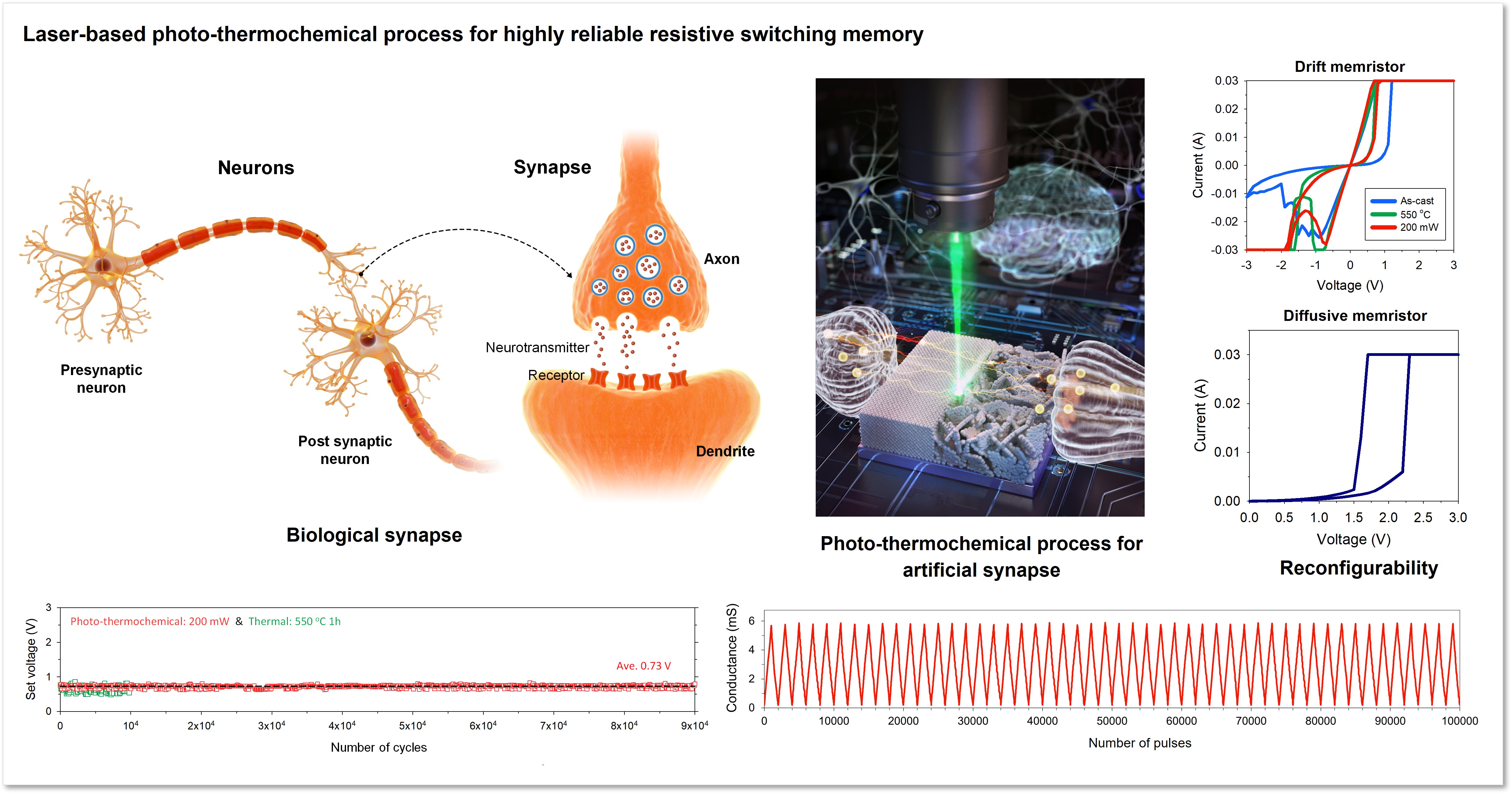

Neuromorphic
Neuromorphic
Research 1
Hardware Implementation of Artificial Neural Network (ANN)
Reliable and robust resistive switching memory (e.g., RRAM)
- Brain-inspired computing paradigm has been investigated as a solution to process unstructured big data efficiently. However, its hardware implementation using the von Neumann architecture-based traditional digital computing system is facing limitations in its computing-speed and energy-efficiency because of the memory-wall issue originated from the data-transfer between processing and memory units through interconnects.
- Processing-in-memory architecture is a promising
solution to resolve these difficulties by integrating processor and memory units.
Specifically, the crossbar array architecture, composed of analog two-terminal resistive switching memory [e.g., resistive random access memory (RRAM)] devices as synaptic elements, has attracted significant intersts as a promising candidate to build this architecture for implementing
the hardware neural network due to natural massive parallelism accelerating its computing ability without
latency and energy-consumption, high density, and superior electrical properties.
- However, uncontrollable
random filament formation through an amorphous medium induces its
reliability issues, which has been a fundamental challenge, hampering
this technology to be a basis for achieving a high accuracy large-scale artificial neural network (ANN) in
the form of crossbar array. Crystalline switching mediums with defects,
where the metal filaments can be confined, have been also prepared for more precise
controllability, but high process temperature is not feasible to the back
end of line (BEOL) process for a complementary
metal-oxide semiconductor (CMOS) circuit. Morever, the investigated material systems are
not strong enough.
- We are investigating fundamental solutions that can resolve this reliability
issue of the RSMs. They should have excellent conductance tunability (linear and symmetric) and large conductance states with high dynamic range. Moreover, their temporal and spatial
performance variation should be suppressed and their durability also should be high enough. Those RSMs also should have excellent processibility compatible to BEOL process for CMOS.
- Our goal is realizing various types of large area high accuracy ANN including deep neural network (DNN), convolution neural network (CNN), and reservoir computing.


- Brain-inspired computing paradigm has been investigated as a solution to process unstructured big data efficiently. However, its hardware implementation using the von Neumann architecture-based traditional digital computing system is facing limitations in its computing-speed and energy-efficiency because of the memory-wall issue originated from the data-transfer between processing and memory units through interconnects.
- Processing-in-memory architecture is a promising solution to resolve these difficulties by integrating processor and memory units. Specifically, the crossbar array architecture, composed of analog two-terminal resistive switching memory [e.g., resistive random access memory (RRAM)] devices as synaptic elements, has attracted significant intersts as a promising candidate to build this architecture for implementing the hardware neural network due to natural massive parallelism accelerating its computing ability without latency and energy-consumption, high density, and superior electrical properties.
- However, uncontrollable
random filament formation through an amorphous medium induces its
reliability issues, which has been a fundamental challenge, hampering
this technology to be a basis for achieving a high accuracy large-scale artificial neural network (ANN) in
the form of crossbar array. Crystalline switching mediums with defects,
where the metal filaments can be confined, have been also prepared for more precise
controllability, but high process temperature is not feasible to the back
end of line (BEOL) process for a complementary
metal-oxide semiconductor (CMOS) circuit. Morever, the investigated material systems are
not strong enough.
- We are investigating fundamental solutions that can resolve this reliability issue of the RSMs. They should have excellent conductance tunability (linear and symmetric) and large conductance states with high dynamic range. Moreover, their temporal and spatial performance variation should be suppressed and their durability also should be high enough. Those RSMs also should have excellent processibility compatible to BEOL process for CMOS.
- Our goal is realizing various types of large area high accuracy ANN including deep neural network (DNN), convolution neural network (CNN), and reservoir computing.


In Sensor Computing (artificial visual system)
Photonic synapse


